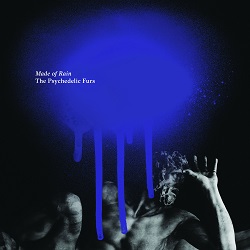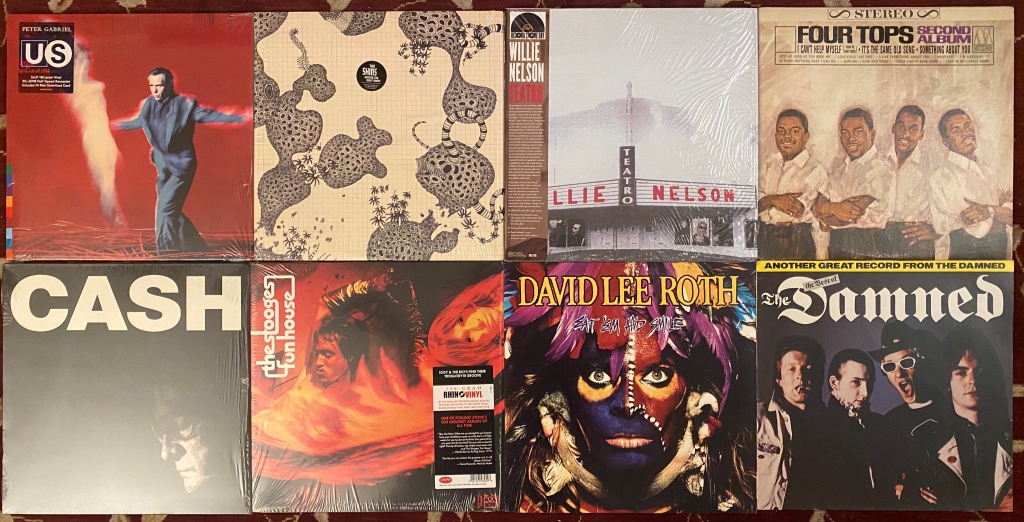
By Joel Francis
Our trawl through my world of vinyl continues.
Various Artists – Stroke It Noel: Big Star’s Third in Concert (2017) To butcher the cliché, probably not everyone who bought a Big Star album back in the ‘70s started a band, but it’s a fair bet that at least one person from most of your favorite bands did (unless you are super into, say, Norwegian death metal, in which case, thank you for branching out and reading this blog).
It’s been ten years to the month since Big Star’s frontman Alex Chilton died on the eve of his celebration at South by Southwest. The impromptu tribute that emerged from that tragedy morphed into a series of concerts around the world celebrating Big Star’s troubling third album. It’s wonderful to hear members of Wilco, R.E.M., Yo La Tengo, the Posies, Semisonic, the dbs and more pass the mic and hike through these songs. But the live reproductions are so faithful they miss the fragile, alluring qualities that made the original studio versions that almost seemed to disintegrate before coalescing into beauty – if they made it that far. So yeah, I dig this, but hearing R.E.M.’s Mike Mills bounce joyfully through “Jesus Christ” or Django Haskins struggle with “Holocaust” doesn’t make me a bigger Big Star fan. It just makes me glad that the people I’m into have such immaculate taste.
Robert Fripp – Exposure (1979) I have a great deal of respect for King Crimson, Robert Fripp’s groundbreaking progressive rock ensemble, but to my heathen ears their music is like listening to calculus. I can get behind Exposure, though. You can almost hear Fripp smirking as he takes the listener from wordless, off-kilter a capella harmonies to an endlessly ringing phone and then a boogie woogie pastiche – all in about a minute. It’s almost like Fripp is daring us to meet us where he is, then abruptly changing course and challenging us to follow him over there. This is also an apt description of his entire career. Listening to Exposure is like playing tag. You never stay in one place and may find yourself out of breath at times with the quarry just out of reach, but it’s always fun to play. Special mention must be made of the definitive version of “Here Comes the Flood” with Peter Gabriel on vocals.
Madisen Ward and the Mama Bear – Skeleton Crew (2015) This mother-son duo was poised to be the next big thing to break out of the Kansas City music scene when this debut album came out. They appeared on one of the last episodes of The Late Show with David Letterman, the Today show, Later with Jools Holland and played Bonnaroo and the Newport Folk Festival. Things have been quiet since then – only one EP in 2018 – but these laid-back, folk blues romps are still a fun spin.
Kendrick Lamar – Damn. (2017) Damn. was my favorite album the year it came out and it remains a compelling listen today. The fact that I can say this despite a concert that nearly left me in tears is a testament to its strength. When the Damn. tour announced a date at the Sprint Center, I quickly jumped on tickets. Not wanting to take out a second mortgage, my friends and I got seats in the upper level, extreme stage right. The sound was fine for the opening acts, but when Lamar took the stage it was like the sound blew out in the speakers directed at our section. You know it sounds you’re just inside the doors, waiting to get in and the show starts without you? All bass with just a hint of vocals? That’s how it sounded inside the arena. Some ushers kindly moved us to another section where the sound was slightly better, but the spell had been broken and the show was a bust. All this and I still can’t wait to hear what Lamar does next.
Rush – Power Windows (1985) I know everyone loves the hard, sci-fi prog of Rush’s late-‘70s peak, but I am strongly partial to their synth-heavy early ‘80s material. This mostly boils down to the fact that during high school I played the band’s 1989 live album A Show of Hands so often I thought the laser would bore right through the CD. So you can have your “Cygnus X-1” and “By-Tor and the Snow Dog” and I’ll stick with “Marathon” and “Manhattan Project,” thank you very much.
Husker Du – Everything Falls Apart (1982) Playing this record (included in the Numero Group’s essential early-days collection Savage Young Du) is like flying down the interstate on a Japanese motorcycle without a helmet. Insects slap your face and the wind stings your eyes as gravity forces you closer to the ground. Danger is imminent, but you twist your wrist and accelerate even more. Stopping is not an option. Oh, and there’s an entire side of bonus tracks.
Johnny Cash – Mean as Hell! (1966) Mean as Hell! is the single platter version of Johnny Cash’s double-record concept album Sings the Ballads of the True West. I think I got this at a garage sale, because who can resist an album with this title (with mandatory exclamation point) where a gaunt, drugged out Cash is dressed like a cowboy, holding a gun? The music isn’t as exceptional as the cover. The spoken-word bits are a little too somber. Cash sounds like a Southern preacher crossed with a National Geographic narrator on the title track and the studio version of “25 Minutes to Go” is nowhere near as fun as the live version at Folsom Prison. Despite these shortcomings, I’ll still put on my spurs for the ballads: “I Ride an Old Paint,” “Sweet Betsy from Pike” and album closer “Bury Me Not on the Lone Prairie.”
Frank Black – Teenager of the Year (1994) No one liked this album when it came out. It didn’t sound like the Pixies, wasn’t as radio-ready as the Breeders and there was a lot of lingering animosity over how Frank Black ended the beloved Pixies. I didn’t know any of this at the time, however, because I was too busy listening to A Show of Hands. Coming to this album several years later, all I heard were nearly two dozen bright blasts of Black’s songwriting at its most accessible. Nurse a grudge all you want. I’ll be right over hear blasting “Freedom Rock” loud enough to drown out your whining.
Brian Eno – Reflection (2016) I don’t know enough about ambient music to tell you the difference between this album and Lux or the longer-form pieces on the Music for Installations collection. I can tell you that when it gets to the point in the day when I need some Eno, Reflection (and Lux) always comforts me. I also don’t think I have to get up to turn the record over as often with Lux, so there’s one difference.
Bruce Springsteen – The Wild, The Innocent and the E-Street Shuffle (1973) This is one of my absolute favorite Springsteen albums because it’s the sound of him fumbling through different sounds trying to figure out what he wants to be. It all clicked into place with Born to Run, his next album. The guitars at the beginning of “Sandy” sound like the Allman Brothers Band before the accordion whisks in foreshadowing the opening section of Billy Joel’s “Scenes from an Italian Restaurant.” Where else can you hear Springsteen rocking with a clavinet over a Doobie Brothers guitar line but on “The E Street Shuffle”?
The picture of the band is especially priceless. Half the guys have their shirts unbuttoned all the way, only a couple are wearing shoes and Springsteen is rocking a tank top and blue jeans. They look like a group that would get uncomfortably close and overly friendly with a stranger, ask to bum a cigarette and then inquire if he or she liked to par-tay.
Wild and Innocent is also the only time multi-instrumentals David Sancious appeared as Springsteen’s main musical foil. Sancious left to form his own band shortly after this album came out and went on to work with Stanley Clarke, Peter Gabriel, Sting, Eric Clapton and many others.
Lee Hazlewood – The LHI Years: Singles, Nudes and Backsides (compilation) If you’ve heard “These Boots,” then you’ve heard a Lee Hazlewood production. This collection doesn’t contain any of Hazlewood’s work with the Chairman of the Board’s daughter – which is good enough to warrant its own anthology – but it does contain duets with Ann-Margret and Suzi Jane Hokom and solo cuts that sound like cowboy songs in Cinemascope. Drag Phil Spector’s Wall of Sound to the wild west and your getting close.
R.L. Burnside – Too Bad Jim (1994)
T-Model Ford – The Ladies Man (2010) I saw T-Model Ford one time, right around the time The Ladies Man came out, a couple years before his death. The venue, Davey’s Uptown Rambler’s Club, or just Davey’s, was about as close as you could get to a juke joint in Kansas City. Split across two storefronts, the bar was on the left side, where you’d traditionally enter. The area with music was on the right side of the wall. If a performer moved too far stage right he or she was liable to bump into a door leading out to the street. That would be bad. Despite these shortcomings, the sight lines were decent, the drinks were cheap and the sound was usually OK. I mention all this because Davey’s, a century-old Kansas City institution, was gutted by a fire just a couple days ago. Everyone reminiscing online about the great times they had at the venue made me reach for this album.
R.L. Burnside’s blues were cut from the same primitive cloth as Ford’s. I don’t know if Burnside ever played at Davey’s but I’m sure he would have been welcomed and would have liked it. The good news is that the Markowitz family, who have run Davey’s since the 1950s, plan to rebuilt the space.
Loose Fur – self-titled (2003) Recorded before Wilco’s career-defining Yankee Hotel Foxtrot but released afterward, Loose Fur is the sound of Jeff Tweedy shaking off the weight of Wilco and getting acquainted with two new collaborators. Opening track “Laminated Cat” is one of my favorite Tweedy compositions. It’s more than seven minutes here, but Wilco frequently tear it down onstage like a Sonic Youth number and stretch it even longer. Jim O’Rourke’s “Elegant Transaction” provides a more relaxed counterpoint and while the album doesn’t get that relaxed again until the closing number, “Chinese Apple,” the opening pair frame the album as a balancing act between tension, experimental noise and release.
Benny Carter – Further Definitions (1961) Impulse Records are frequently viewed as the playhouse for avant-garde jazz workouts by saxophonists John Coltrane, Archie Shepp, Yusef Lateef and Sonny Rollins. Further Definitions is proof that Impulse wasn’t so one-dimensional (at least in the early years). Pre-war legends Benny Carter and Coleman Hawkins push each other to new heights in the confines of this small group anchored by Coltrane’s rhythm section. The result is an album that jazz fans can appreciate for its sophistication and intricacy but your mom can hum along with. A win for everyone.















